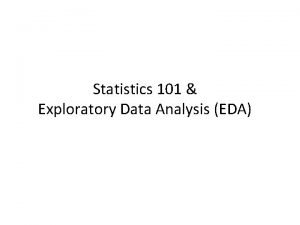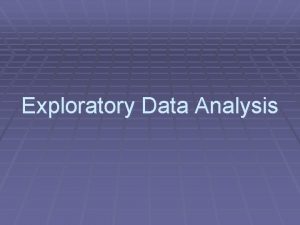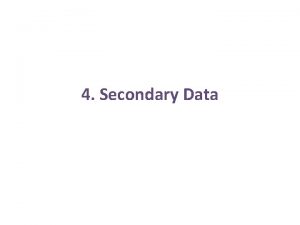Chapter Four Exploratory Research Design Secondary Data Copyright


























- Slides: 26

Chapter Four Exploratory Research Design: Secondary Data Copyright © 2010 Pearson Education, Inc. publishing as Prentice Hall 4 -1

Primary Vs. Secondary Data • Primary data are originated by a researcher for the specific purpose of addressing the problem at hand. • Secondary data are data that have already been collected for purposes other than the problem at hand. These data can be located quickly and inexpensively. Copyright © 2010 Pearson Education, Inc. publishing as Prentice Hall 4 -2

Secondary Data • The data are often found internally, and also from published materials, computerized databases, or from syndicated services Copyright © 2010 Pearson Education, Inc. publishing as Prentice Hall 4 -3

Scope of secondary data • Secondary data can cover a broad range of factors that affect the problem at hand. • It does not always fit the specific problem at hand, but can be useful in developing an approach to the problem and providing a comprehensive understanding of the problem environment. Copyright © 2010 Pearson Education, Inc. publishing as Prentice Hall 4 -4

A Comparison of Primary & Secondary Data Table 4. 1 Collection purpose process cost time Primary Data Secondary Data For the problem at hand Very involved High Long For other problems Rapid & easy Relatively low Short Copyright © 2010 Pearson Education, Inc. publishing as Prentice Hall 4 -5

Criteria for Evaluating Secondary Data • Specifications: Methodology Used to Collect the Data • Error: Accuracy of the Data • Objective(s): The Purpose for Which the Data Were Collected • Nature: The Content of the Data • Dependability: Overall, How Dependable Are the Data Copyright © 2010 Pearson Education, Inc. publishing as Prentice Hall 4 -6

A Classification of Secondary Data Fig. 4. 1 Secondary Data Internal Ready to Use Requires Further Processing External Published Materials Copyright © 2010 Pearson Education, Inc. publishing as Prentice Hall Computerized Databases Syndicated Services 4 -7

Internal Secondary Data Department Store Project Sales were analyzed to obtain: • Sales by product line • Sales by major department (e. g. , men's wear, house wares) • Sales by specific stores • Sales by geographical region • Sales by cash versus credit purchases • Sales in specific time periods • Sales by size of purchase • Sales trends in many of these classifications were also examined Copyright © 2010 Pearson Education, Inc. publishing as Prentice Hall 4 -8

Type of Individual/Household Level Data Available from Syndicated Firms I. Demographic Data - Identification (name, address, email, telephone) - Sex - Marital status - Names of family members - Age (including ages of family members) - Income - Occupation - Number of children present - Home ownership - Length of residence - Number and make of cars owned Copyright © 2010 Pearson Education, Inc. publishing as Prentice Hall 4 -9

Type of Individual/Household Level Data Available from Syndicated Firms II. Psychographic Lifestyle Data - Interest in golf - Interest in snow skiing - Interest in book reading - Interest in running - Interest in bicycling - Interest in pets - Interest in fishing - Interest in electronics - Interest in cable television There also firms such as Dun & Bradstreet and American Business Information which collect demographic data on businesses. Copyright © 2010 Pearson Education, Inc. publishing as Prentice Hall 4 -10

A Classification of Published Secondary Sources Fig. 4. 2 Published Secondary Data Government Sources General Business Sources Guides Directories Indexes Statistical Data Copyright © 2010 Pearson Education, Inc. publishing as Prentice Hall Census Data Other Government Publications 4 -11

Syndicated Services • Syndicated services are companies that collect and sell common pools of data of known commercial value designed to serve a number of clients • Syndicated sources can be classified based on the unit of measurement (households/consumers or institutions) • Household/consumer data may be obtained from surveys, diary panels, or electronic scanner services • Institutional data may be obtained from retailers, wholesalers, or industrial firms Copyright © 2010 Pearson Education, Inc. publishing as Prentice Hall 4 -12

A Classification of Syndicated Services Fig. 4. 4 Unit of Measurement Households/ Consumers Copyright © 2010 Pearson Education, Inc. publishing as Prentice Hall Institutions 4 -13

A Classification of Syndicated Services • Household services emphasize the consumer. The most popular form of measurement is the survey, although the use of electronic scanner services is growing in importance. Electronic scanner data? Copyright © 2010 Pearson Education, Inc. publishing as Prentice Hall 4 -14

Electronic scanner data? • Detailed data on sales of consumer goods obtained by 'scanning' the bar codes for individual products at electronic points of sale in retail outlets. The data can provide detailed information about quantities, characteristics and values of goods sold as well as their prices Copyright © 2010 Pearson Education, Inc. publishing as Prentice Hall 4 -15

Electronic scanner data? Advantages: 1. The data collected are free from any biases. 2. In-store variables, such as pricing, promotions, and displays, are part of the data set. 3. The data are likely to be more current as compared to other methods. 4. The data reflect actual purchases, not just intended purchases. Disadvantages: 1. Scanner services are limited as to geographical dispersion. 2. Quality of scanner data may be impaired due to various factors. For example, not all product categories may be scanned, the item may not scan on the first try, etc. Copyright © 2010 Pearson Education, Inc. publishing as Prentice Hall 4 -16

Panels • A panel as a sample of respondents that provide specified information at regular intervals over an extended period of time. The distinguishing feature of purchase panels is that the respondents in the panel are required to record specific behaviors as they occur. • In media panels, the behavior is automatically recorded by electronic devices. Copyright © 2010 Pearson Education, Inc. publishing as Prentice Hall 4 -17

Panels Advantages: • 1. Panels provide longitudinal data, i. e. data obtained from the same respondents repeatedly. • 2. Panel members may provide higher quality data than would a sample because of their willingness to serve on the panel. Disadvantages: 1. Most panels are not representative 2. Over a period of time maturation sets in and the panel members must be replaced. 3. Response biases may occur as simply being on the panel may alter behavior. Copyright © 2010 Pearson Education, Inc. publishing as Prentice Hall 4 -18

Usefulness of psychographics and AIO • Psychographics as psychological characteristics of consumers that can be quantified. • They can then be classified as consisting of two types of variables: lifestyle and personality. Copyright © 2010 Pearson Education, Inc. publishing as Prentice Hall 4 -19

Usefulness of psychographics and AIO • A lifestyle may be defined as a distinctive pattern of living that is described by the activities people engage in, the interests they have, and the opinions they hold of themselves and the world around them. • These activities, interests, and opinions are termed AIOs. The AIOs can be used to segment people into groups with different lifestyles and then the marketing effort can be geared to meet the needs of any group(s). Copyright © 2010 Pearson Education, Inc. publishing as Prentice Hall 4 -20

Scanner data • Three types of scanner data are available: volume tracking data, scanner panels, and scanner panels with cable TV. • The volume tracking data provide information on purchases by brand, size, price, and flavor or formulation based on sales data collected from the checkout scanner tapes. • In scanner panels, each household member is given an ID card that looks like a credit card. After shopping, the panel member presents the ID card at the beginning of the checkout process. Copyright © 2010 Pearson Education, Inc. publishing as Prentice Hall 4 -21

scanner data • This data can be used by marketing researchers in a variety of ways. National volume tracking data can be used for tracking sales and prices, distribution analysis, modeling, and early warning signal analysis Copyright © 2010 Pearson Education, Inc. publishing as Prentice Hall 4 -22

scanner data • An advanced use of scanning combines panels with the cable TV industry. Households on these panels subscribe to one of the cable TV systems. • Scanner panels with cable TV can be used for new product testing, product repositioning, promotional mix analysis, advertising decisions including budget, copy, and media decisions, and pricing analysis. Copyright © 2010 Pearson Education, Inc. publishing as Prentice Hall 4 -23

The sources of international market information Important government sources are: • Department of Commerce • Agency for International Development • Small Business Administration • Export-Import Bank • Department of Agriculture • Department of State • Department of Labor • Port Authority Copyright © 2010 Pearson Education, Inc. publishing as Prentice Hall 4 -24

The sources of international market information Nongovernment organizations: • United Nations • Organization for Economic Cooperation and Development (OECD) • International Monetary Fund (IMF) • World Bank, International Chambers of Commerce • Commission of the European Community to the United States • Japanese External Trade Organization (JETRO). Copyright © 2010 Pearson Education, Inc. publishing as Prentice Hall 4 -25

All rights reserved. No part of this publication may be reproduced, stored in a retrieval system, or transmitted, in any form or by any means, electronic, mechanical, photocopying, recording, or otherwise, without the prior written permission of the publisher. Printed in the United States of America. Copyright © 2010 Pearson Education, Inc. publishing as Prentice Hall 4 -26
 Exploratory research secondary data
Exploratory research secondary data Exploratory research secondary data
Exploratory research secondary data Confirmatory research
Confirmatory research Distinguish between exploratory and conclusive research
Distinguish between exploratory and conclusive research What is a reseach
What is a reseach Cross sectional vs longitudinal
Cross sectional vs longitudinal Hidden issue questioning example
Hidden issue questioning example Research design is a blueprint outline and a plan
Research design is a blueprint outline and a plan Objectives of literature review
Objectives of literature review Exploratory research is __________.
Exploratory research is __________. Exploratory, descriptive and causal research
Exploratory, descriptive and causal research Broad problem area in research examples
Broad problem area in research examples Component of research design
Component of research design Experience survey in exploratory research
Experience survey in exploratory research Qualitative research procedures
Qualitative research procedures Research design
Research design Exploratory, descriptive and causal research
Exploratory, descriptive and causal research Difference between exploratory and conclusive research
Difference between exploratory and conclusive research Exploratory data analysis lecture notes
Exploratory data analysis lecture notes Exploratory data analysis definition
Exploratory data analysis definition Copyright secondary sara (2017) answers
Copyright secondary sara (2017) answers Secondary data are
Secondary data are Syndicated services in marketing research
Syndicated services in marketing research The terms external secondary data and syndicated
The terms external secondary data and syndicated Content analysis secondary data
Content analysis secondary data Management research question hierarchy
Management research question hierarchy Primary data and secondary data
Primary data and secondary data














































